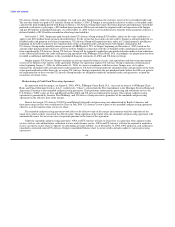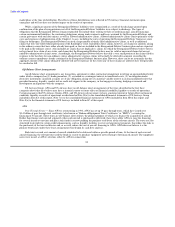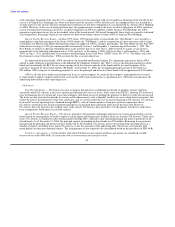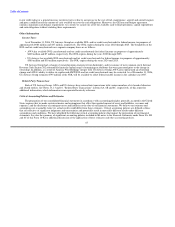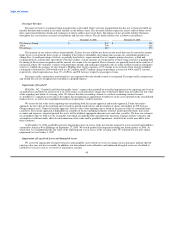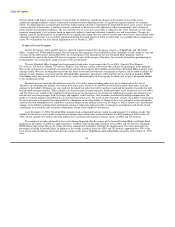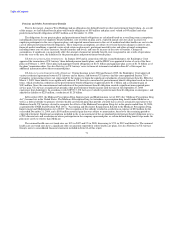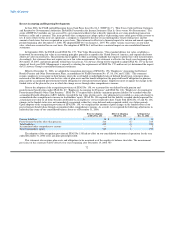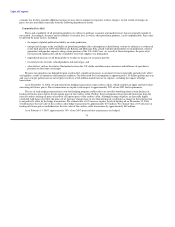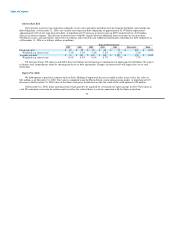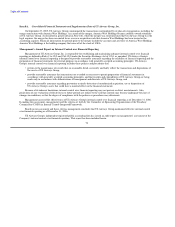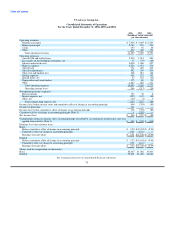US Airways 2006 Annual Report Download - page 72
Download and view the complete annual report
Please find page 72 of the 2006 US Airways annual report below. You can navigate through the pages in the report by either clicking on the pages listed below, or by using the keyword search tool below to find specific information within the annual report.
Table of Contents
Factors which could trigger an impairment review include the following: significant changes in the manner of use of the assets;
significant underperformance relative to historical or projected future operating results; or significant negative industry or economic
trends. An impairment has occurred when the future undiscounted cash flows estimated to be generated by those assets are less than the
carrying amount of those items. Cash flow estimates are based on historical results adjusted to reflect management's best estimate of
future market and operating conditions. The net carrying value of assets not recoverable is reduced to fair value. Estimates of fair value
represent management's best estimate based on appraisals, industry trends and reference to market rates and transactions. Changes in
industry capacity and demand for air transportation can significantly impact the fair value of aircraft and related assets. International route
authorities and trademarks were tested for impairment during the fourth quarter of 2006, at which time we concluded that no impairment
exists. We will perform our next annual impairment test on October 1, 2007.
Frequent Traveler Programs
Prior to the merger, AWA and US Airways operated separate frequent flyer programs, known as "FlightFund" and "Dividend
Miles," respectively. Following the merger, the two frequent flyer programs were modified to allow customers of each airline to earn and
use miles on the other airline, and in May 2006, the two programs were merged into the new Dividend Miles program, which is
substantially the same as the former US Airways program. As part of the merger of the plans, the accounts of members participating in
both programs were merged into single accounts of the new program.
The new Dividend Miles frequent traveler program awards miles to passengers who fly on AWA, America West Express,
US Airways, US Airways Shuttle, US Airways Express, Star Alliance carriers and certain other airlines that participate in the program.
We use the incremental cost method to account for the portion of its frequent flyer liability incurred when Dividend Miles members earn
mileage credits. We have an obligation to provide this future travel and have therefore recognized an expense and recorded a liability for
mileage awards. Expense associated with the Dividend Miles program is allocated to AWA and US Airways based on mainline RPMs.
Outstanding miles may be redeemed for travel on any airline that participates in the program, in which case we pay a designated amount
to the transporting carrier.
Members may not reach the threshold necessary for a free ticket and outstanding miles may not be redeemed for free travel.
Therefore, in calculating the liability we estimate how many miles will never be used for an award and exclude those miles from the
estimate of the liability. Estimates are also made for the number of miles that will be used per award and the number of awards that will
be redeemed on partner airlines. These estimates are based on past customer behavior. Estimated future travel awards for travel on AWA
and US Airways are valued at the combined estimated average incremental cost of carrying one additional passenger. Incremental costs
include unit costs for passenger food, beverages and supplies, credit card fees, fuel, insurance and denied boarding compensation. No
profit or overhead margin is included in the accrual for incremental costs. For travel awards on partner airlines, the liability is based upon
the gross payment to be paid to the other airline for redemption on the other airline. A change to these cost estimates, actual redemption
activity or award redemption level could have a material impact on the liability in the year of change as well as future years. Incremental
changes in the liability resulting from participants earning or redeeming mileage credits or changes in assumptions used for the related
calculations are recorded in the statement of operations as part of the regular review process.
As of December 31, 2006, Dividend Miles members had accumulated mileage credits for approximately 3.8 million awards. The
liability for the future travel awards accrued on our balance sheet within other accrued liabilities was $201 million as of December 31,
2006. Of this amount, $35 million and $166 million were accrued on the respective balance sheets of AWA and US Airways.
The number of awards redeemed for free travel during the period after the merger of the former Dividend Miles and Flight Fund
programs to December 31, 2006 was approximately 0.5 million, representing approximately 4% of AWA and US Airways' combined
RPMs during that period. The use of certain inventory management techniques minimize the displacement of revenue passengers by
passengers traveling on award tickets. In addition to the awards issued for travel on AWA and US Airways, approximately 10% of the
total awards redeemed during the period after the merger of the former FlightFund and Dividend Miles programs to December 31, 2006
were
69




